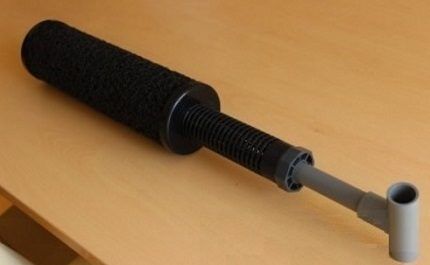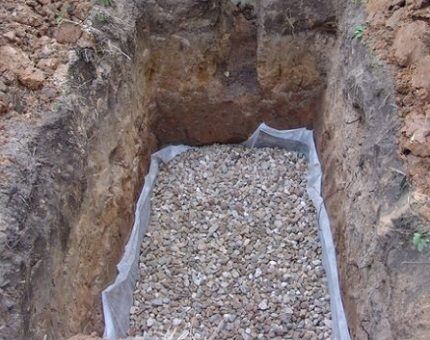Review of the septic tank "Voskhod": characteristics, model range, installation rules
Few people are happy with cesspools anymore. The need for frequent professional cleaning is not their only drawback.Outdated technologies have been replaced by universal modular designs that make it possible to organize an autonomous sewage system on the site.
The most economical solution to the issue of disposal of household waste is the Voskhod septic tank. The model has the following advantages: simple installation, low maintenance and long service life.
In this material we will tell you everything about the structure and operating principle of a septic tank, outline its advantages and disadvantages, and also reveal the secrets of installing a septic tank on the site.
The content of the article:
Device and principle of operation
The septic tank is a key element of the local treatment complex. The main function of the unit is the accumulation and purification of wastewater flowing through the sewer network of the house. The level of contaminant removal and liquid filtration depends on the type of structure.
The Voskhod septic tank is a storage sealed container with strong thick walls, which are reinforced with stiffening ribs. The cylindrical shape of the tank provides good resistance to soil pressure and reliable fixation.
In addition to the large tank, the purifier kit includes:
- neck – the element is designed for pumping out sediment;
- lid – closes the neck, protects the septic tank from foreign objects, leaves, rain and snow getting into it;
- filter – located inside the storage tank, performs biological and mechanical cleaning.
The filter consists of many polymer fibers woven together. The cleaner is not subject to corrosion, oxidation and deformation. Filter components retain waste materials of different fractions. Over time, organic matter undergoes a process of decay and breaks down into small particles.

The Voskhod cleaning system is a classic version of the sump. The device uses the principle of separating wastewater under the influence of gravity and subsequent decomposition of organic substances by anaerobic bacteria - without the participation of oxygen.

Conventionally, the entire cleaning process can be divided into the following stages:
- Wastewater from the house enters the septic tank through sewer pipe.
- Under the influence of gravity, the primary decomposition of waste into heavy and light particles occurs. The sludge in the form of sediment sinks to the bottom of the storage tank, and the suspension and fatty components float to the surface.
- Liquid with fine-fraction waste percolates through a biofilter and is discharged for additional ground treatment (drainage well, filtration field or infiltrator).
If the complex has two tanks, then semi-purified water is drained through pipes into the next tank. The cleaning process is then repeated.

Advantages and disadvantages of the Voskhod model
Owners of summer cottages, houses and cottages who use the Voskhod system note an impressive number of positive aspects and several negative aspects.
The advantages of a water purification system include:
- work autonomy – the septic tank is independent of the power supply;
- high reliability and durability – the tank is designed very simply, there is practically nothing to break in the device;
- ease of installation – installation can be done by yourself;
- affordable pricing policy on the Voskhod model.
Negative user reviews are usually associated with the wrong choice of volume of cleaner or violation of operating rules.

Instead of an absorption well, an infiltrator is used for natural drainage of treated wastewater into the ground or a filtration field is constructed from trenches laid drainage pipes. They perform functions similar to those of a absorption well, but the depth of their conditional bottom is significantly higher.
The choice of the type of structure for ground treatment is related to the groundwater level at the site.It should be taken into account that between the GWL (groundwater level) and the conditional bottom of the well, infiltrator or filtration field there must be a soil thickness of at least 1 m thick.
Additional disadvantages of using a septic tank:
- during operation, some users noted the appearance of an unpleasant odor;
- It is advisable to insulate the cleaning complex for the winter period.
Like most autonomous sewer systems, Voskhod needs timely cleaning - removal of solid sediment. The sewer truck is called out every two to three years - the timing is individual and depends on the operating conditions.
Characteristics of different modifications
Depending on the number of residents, the availability of plumbing equipment and appliances, and therefore the volume of wastewater, a septic tank model is selected. There are two modifications on the market: “Voskhod-1”, “Voskhod-2”.
"Voskhod-1" - a single-chamber installation designed to serve a compact house inhabited by no more than four people. The tank volume is 1400 liters, the maximum permissible wastewater discharge should not exceed 700 liters per day.
"Voskhod-2" — two-chamber model for 2000 l. The tank volume is enough for a family of four to five people. The mass of the storage device is 80 kg, the tank is designed for a liquid flow within the range of 800 liters per day. The model includes overflow pipes connecting both containers. The movement of wastewater occurs by gravity - the outlet is located below the inlet.

The three-chamber model “Voskhod-3” with a capacity of 3000 liters is in less demand.Installation of a septic tank is complicated due to its large dimensions and weight. It is advisable to use a large-volume tank for servicing a house where more than six people live.
Technology for installing a septic tank on site
Voskhod septic tanks are installed according to the same principle as similar models with ground treatment. Conventionally, the entire technological process consists of the following stages: choosing a location, preparing a pit, installing a reservoir, organizing soil treatment and supplying pipes.
Selecting a location: requirements according to SNiP
When determining the location of the Voskhod settling tank, you should be guided by the standards outlined in SNiP: 2.04. 03-85, 2.04.01-85 and 2.04.04-84.

Primary requirements:
- The minimum permissible distance to a nearby flowing reservoir is 10 m, to a standing reservoir – 30 m. The distance to a reservoir with drinking water is from 50 m.
- The distance from the sewage storage tank to trees, gas pipelines or roads is at least 5 m, and to the border of the personal plot - 4 m. Shrubs can be planted no closer than 1 m from the tank.
- The distance between the purifier and the foundation of the outbuilding should be at least 1 m. This eliminates the risk of the structure being washed away when the sump is depressurized.
- It is necessary to retreat 5 m from the living space to the septic tank. This gap is due to sanitary safety, as well as the possible appearance of an unpleasant odor from the treatment plant.
At the same time, it is not worth moving the sump tank to a great distance from the house.If the pipeline exceeds 15 m, then additional inspection wells will have to be installed.

When placing a septic tank, you should take into account the terrain features:
- The disposal system should be installed on a hill - this will reduce the risk of flooding the septic tank with melt or rain water. In this case, the tank level should be lower than the bathroom on the first floor of the house.
- If a well or a well with drinking water on a site is located on a slope, then the septic tank is installed lower along the direction of the slope.
It is necessary to provide in advance for free access of the sewer truck to the septic tank.
The standard length of the hose for pumping is 15 m. If the septic tank is located in the depths of the site, you can use the services of a sludge sucker equipped with a 40 m hose.
Installation of a treatment plant
List of necessary tools and materials:
- bayonet shovel – preparation of the pit and trenches;
- sand and crushed stone – formation of a sand cushion;
- concrete slab – if the septic tank is installed in loam or clay;
- polyethylene – arrangement of a moisture-proof layer.
The entire technological process is divided into several stages.
Step 1. Determine the optimal location for installing a sedimentation tank and allocate an area for organizing soil tertiary treatment. Mark the area.
Step 2. Dig a pit for the tank and trenches for laying sewer pipes.

Step 3. At this stage, it is necessary to prepare a site for the arrangement of drainage of semi-purified liquid from the septic tank. The dimensions of the pit depend on the type of post-treatment system (drainage well, filtration field).
Step 4. Fill the pit for the storage tank with sand - the layer thickness is about 20-30 cm. Compact the sand cushion.

Step 5. Compact the trench for the pipeline with a sand layer and install sewer pipes. It is important to endure slight slopeso that the pipes do not become clogged during operation.
Step 6. To prevent pipe deformation, it is advisable to fill them with crushed stone. This measure is relevant if a load is expected in the area above the PVC pipeline. For example, arrangement of a parking lot, playground or patio.
Step 7 Inspect the septic tank, lower it into the pit and check the evenness of the location - any distortions must be excluded.

Step 8 Connect the inlet and outlet pipes, fill the tank halfway with water and begin backfilling. The work is carried out in stages, each layer is carefully compacted. For backfilling, you can use earth or a dry mixture of soil extracted from a pit, river or quarry sand and cement.
Organization of ground wastewater treatment
A special feature of the Voskhod brand septic tank is the need for additional filtration of waste liquid.
Methods for implementing soil purification:
- drainage well;
- filter ditches;
- filter field.
Drainage well. This option is suitable for garden plots with well-drained soil (sandy, gravel, crushed stone). An outlet pipe is laid from the main purifier, through which the liquid flows into a well with filter components.

The structure is erected from monolithic reinforced concrete, brick or stone. If necessary, additional lateral drainage is installed at the bottom of the well (about 1 m), holes are distributed, the total area of which is equal to 10-12% of the total area of the walls. The outlet pipe from the septic tank is connected to the installation at a distance of half a meter from the bottom filter. The depth of the well depends on the volume of wastewater entering it for processing.
Features of the drainage well:
- the conditional bottom of the structure must rise above the highest groundwater level by at least 1 m;
- if, when digging a trench at a depth of 2.5 m, sand, gravel deposits or similar soil with high filtration properties are not found, another method of ground tertiary treatment should be preferred;
- the efficiency of complex cleaning coupled with soil processing is 98-100%.
An expensive, but quick and convenient way to set up a ground treatment system is installation of infiltrators:
If there is a reservoir or ravine near a suburban area into which purified liquid can be discharged, arrange filter ditches.
Their depth depends on the installation level of the pipe leaving the septic tank. At the surface of the earth, the width of the ditch is 80-100 cm, and below - 50 cm. The length of the ditch is selected at the rate of: 1 m of trench per 60 liters of wastewater per day. The trench is filled with filter material: sand, crushed stone, gravel.

Features of the design and operation of the ground treatment system:
- “perforated pipes” are placed with a slope in the direction of drainage of 2 - 3 mm per linear meter;
- purified water flows through a drainage pipe into the nearest ravine or reservoir;
- the size of the holes in the pipeline is 4-7 mm, the perforation pitch is 10-20 cm;
- cleaning efficiency – up to 98%.
Underground filtration field. A network of drainage trenches equipped with a sand and gravel bed. Unlike filter ditches, perforated field pipes - drains are laid in one tier. Seeping through the holes, water from the septic tank undergoes further purification, and then the purified liquid enters the environment.

The need to insulate the septic tank and pipeline
The standards and requirements for the installation of a plastic septic tank “Voskhod” imply year-round operation of the installation without the use of additional insulation means.
The reservoir is immersed deep enough to prevent icing of the water. The sewer pipe network is placed at a slope - this prevents stagnation of water and the appearance of ice jams. In addition, the influx of wastewater and the fermentation process in the settling tank contributes to the release of heat.
However, even if the installation technology is followed, there is a risk of accidents.
Possible reasons:
- Seasonal use of sewerage with periods of “stagnation” can cause freezing of the liquid in the tank. The problem is especially relevant for “country” septic tanks.
- The depth of soil freezing is an average value. There is no guarantee that the coming winter will not be very harsh.
- Local soil deformation due to frost heaving can affect the slope of the pipeline in a separate section. This can lead to water stagnation and ice formation.
It is better to play it safe and insulate the septic tank at the stage of its installation. Suitable heat insulators include: mineral wool, expanded clay, polystyrene foam and extruded polystyrene foam.

A higher quality material is polystyrene foam. Minimal moisture absorption and high strength made it popular for insulating septic tanks.
Thermal insulation of supply pipes is carried out with mineral wool or any pipe insulation. An alternative method is heating cables.
Rules for operation and maintenance of a septic tank
To ensure efficient operation, extend service life and reduce the cost of cleaning a septic tank, it is important to follow the rules of its operation:
- The following items must not be disposed of in sewers transporting waste: cement residues, construction waste, plastic bags, medications (especially antibiotics), and motor oil.
- It is advisable to use biodegradable household products for laundry and dishwashing. Such a product is marked “BR”.
- To avoid clogging of pipes and problems with pumping out sludge, you should use water-soluble toilet paper.
To improve the degree of purification, biological products can be added to the Voskhod septic tank. Concentrated products contain colonies of bacteria that accelerate the decomposition of organic matter.
Important advantages of using additives: elimination of unpleasant odors and reduction of solid waste. Popular drugs: “Vodogray”, “Mikrozim”, “Biosept”, "Doctor Robik" And "Sanex".

Timely cleaning of the septic tank extends the service life of groundwater treatment systems. With stable use of the cleaning complex, a complete replacement of the filter components (gravel and crushed stone) is carried out once every 10 years.
Conclusions and useful video on the topic
Step-by-step installation of a septic tank in conditions of high groundwater:
Septic tank Voskhod is an affordable and practical solution for organizing an autonomous sewer system. The device is distinguished by its simplicity and low maintenance. Having studied the standards for placing a sump tank and having understood the technological requirements for its installation, you will be able to install the septic tank yourself, without the involvement of specialists.
Still have questions about the topic of the article? Or do you already have experience using a Voskhod septic tank and can you share your impressions? Please tell our website visitors which septic tank model you chose? Leave your comments, ask questions, share your experience in the block below.




How strong and reliable is this septic tank? Stiffening ribs are, of course, good, but can it fully withstand soil pressure? It’s confusing that there are practically no reviews of this septic tank from people on the Internet.
Good afternoon, Peter.The thickness of the outer wall is 15 mm, in combination with stiffening ribs, it is quite enough to withstand soil pressure.
Understand correctly, it is not profitable for any manufacturer to produce low-quality products and subsequently receive a large number of complaints. If installed correctly, there will be no problems regarding maintaining the integrity of the container.
The small number of reviews about this septic tank is due to its unpopularity. The reason is primarily due to poor wastewater treatment. The private sector prefers septic tanks with deep cleaning, which is about 98%, which allows the treated wastewater to be immediately discharged into the ditch. Purification of wastewater with the Voskhod septic tank, as you noticed, is within 60-70% and requires further arrangement of a drainage well, filtration field or ditch.